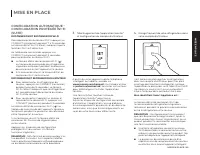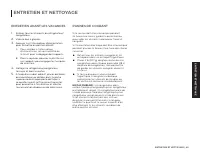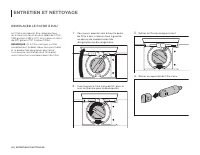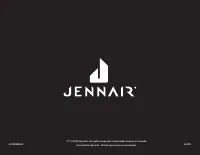CONNECTED APPLIANCE; OEM RESPONSIBILITIES TO COMPLY WITH - JennAir JBRFL30IGX - Manuel d'utilisation - Page 3

Table des matières:
- Page 3 – CONNECTED APPLIANCE; OEM RESPONSIBILITIES TO COMPLY WITH
- Page 5 – Votre sécurité et celle des autres est très importante.; AVERTISSEMENT; SÉCURITÉ
- Page 6 – Renseignements importants à propos de la; MISE AU REBUT DU VIEUX; Avant de jeter votre vieux réf rigérateur ou; Risque de Suffoquer
- Page 7 – ENREGISTREMENT DE; Rationalisez votre service de garantie; IDENTIFICATION DU PRODUIT
- Page 8 – CARACTÉRISTIQUES DU PRODUIT
- Page 10 – COMMANDES DU RÉFRIGÉRATEUR; Afficher et régler la température
- Page 11 – Max Cool
- Page 12 – COMMANDES DU CONGÉLATEUR
- Page 14 – MISE EN PLACE; AVANT UTILISATION; COMMANDE DE LA TEMPÉRATURE À DISTANCE
- Page 15 – MISE EN P; FONCTION DE RÉSEAU INTELLIGENT
- Page 16 – CONFIGURATION AUTOMATIQUE –; SI LA CONNEXION ÉCHOUE :
- Page 17 – DÉCONNEXION ET RECONNEXION WI-FI; Mon identifiant Smart Appliance est :
- Page 18 – CONFIGURATION MANUELLE
- Page 19 – TABLETTES; POUR ENLEVER ET RÉINSTALLER LA
- Page 20 – ENTRETIEN ET NETTOYAGE; NETTOYAGE; Risque d’explosion; ENTRETIEN DU PANNEAU EN CUIR
- Page 21 – ENTRETIEN ET NET; ENTRETIEN AVANT LES VACANCES
- Page 22 – REMPLACER LE FILTRE À EAU
- Page 24 – DÉPANNAGE; UTILISATION
- Page 25 – DÉP; TEMPÉRATURE ET HUMIDITÉ
- Page 26 – LAMPES
- Page 27 – SI VOUS AVEZ BESOIN DE SERVICE; AU CANADA; POUR PLUS D’ASSISTANCE; ACCESSOIRES; FILTRE À EAU DE RECHANGE :
- Page 28 – AVIS D’APPLICATION DE LA RÉGLE-; RESPONSABILITÉS DU FEO À SATISFAIRE
- Page 29 – ÉTIQUETTE DE PRODUIT
- Page 31 – FICHE DE DONNÉES RELATIVES AU RENDEMENT (SUITE)
- Page 32 – SI VOUS AVEZ BESOIN DE SERVICE :; GARANTIE LIMITÉE DE DIX ANS
26 | ASSISTANCE
ASSISTANCE
CONNECTED APPLIANCE
REGULATORY NOTICES
Federal Communications Commission
(FCC) Compliance Notice
This equipment has been tested and found to
comply with the limits for a Class B digital device,
pursuant to Part 15 of the FCC Rules. These limits are
designed to provide reasonable protection against
harmful interference in a residential installation.
This equipment generates, uses, and can radiate
radio frequency energy and, if not installed and
used in accordance with the instructions, may cause
harmful interference to radio communications.
However, there is no guarantee that interference
will not occur in a particular installation. If this
equipment does cause harmful interference to radio
or television reception, which can be determined
by turning the equipment off and on, the user is
encouraged to try to correct
the interference by one of the following measures:
Q
Reorient or relocate the receiving antenna.
Q
Increase the separation between the equipment
and receiver.
Q
Connect the equipment into an outlet on a
circuit different
from that to which the receiver is connected.
Q
Consult the dealer or an experienced radio/TV
technician for help.
This device complies with Part 15 of the FCC Rules.
Operation is subject to the following two conditions:
1.
This device may not cause harmful interference,
and
2.
This device must accept any interference
received, including interference that may cause
undesired operation.
Changes or modifications not expressly approved by
the party responsible for compliance could void the
user’s authority to operate the equipment.
RF Exposure Information
To comply with FCC/IC RF exposure requirements
for mobile transmitting devices, this transmitter
should only be used or installed at locations where
there is at least 20 cm separation distance between
the antenna and all persons.
To comply with FCC/IC RF exposure limits for
general
population/uncontrolled exposure, the antenna(s)
used for this transmitter must be installed to provide
a separation distance of at least 20 cm from all
persons and must not be co-located or operating in
conjunction with any other antenna or transmitter.
Industry Canada (IC) Compliance Notice
This Device complies with Industry Canada License-
exempt RSS standard(s). Operation is subject to the
following two conditions:
1.
This device may not cause interference,
2.
This device must accept any interference,
including interference that may cause undesired
operation of the device.
Under Industry Canada regulations, this radio
transmitter may only operate using an antenna of a
type and maximum (or lesser) gain approved for the
transmitter by Industry Canada. To reduce potential
radio interference to other users, the antenna type
and its gain should be so chosen that the equivalent
isotropically radiated power (e.i.r.p.) is not more than
that necessary for successful communication.
This radio transmitter IC: 10248A-XPWG3 has been
approved by Industry Canada to operate with the
antenna types listed below with the maximum
permissible gain and required antenna impedance
for each antenna type indicated. Antenna types not
included in this list, having a gain greater than the
maximum gain indicated for that type, are strictly
prohibited for use with this device.
Antenna Type
Maximum
Permissible
Antenna Gain
(dBi)
Required
Impendance
(OHM)
Slot
1.76
50
To comply with FCC and Industry Canada RF
radiation exposure limits for general population,
the antenna(s) used for this transmitter must be
installed such that a minimum separation distance
of 20 cm is maintained between the radiator
(antenna) and all persons at all times and must not
be co-located or operating in conjunction with any
other antenna or transmitter.
Le présent appareil est conforme aux CNR
d’Industrie Canada applicables aux appareils radio
exempts de licence. L’exploitation est autorisée aux
deux conditions suivantes :
(1) l’appareil ne doit pas produire de brouillage, et
(2) l’utilisateur de l’appareil doit accepter tout
brouillage radioélectrique subi, même si le
brouillage est susceptible d’en compromettre le
fonctionnement.
Conformément à la réglementation d’Industrie
Canada, le présent émetteur radio peut fonctionner
avec une antenne d’un type et d’un gain maximal
(ou inférieur) approuvé pour l’émetteur par Industrie
Canada. Dans le but de réduire les risques de
brouillage radioélectrique à l’intention des autres
utilisateurs, il faut choisir le type d’antenne et son
gain de sorte que la puissance isotrope rayonnée
équivalente (p.i.r.e.) ne dépasse pas l’intensité
nécessaire à l’établissement d’une communication
satisfaisante.
Le présent émetteur radio IC : 10248A-XPWG3 a été
approuvé par Industrie Canada pour fonctionner
avec les types d’antenne énumérés ci-dessous et
ayant un gain admissible maximal et l’impédance
requise pour chaque type d’antenne. Les types
d’antenne non inclus dans cette liste, ou dont
le gain est supérieur au gain maximal indiqué,
sont strictement interdits pour l’exploitation de
l’émetteur.
Type
d’antenne
Gain admissible
maximal d’antenne
(dBi)
L’impédance
requise
(OHM)
Slot
1.76
50
Pour satisfaire aux exigences de la FCC et IC
d’exposition aux radiofréquences, une distance de
séparation de 20 cm ou plus doit être maintenue
entre cet appareil et des personnes lors de
fonctionnement du dispositif. Pour assurer la
conformité des opérations au plus près que cette
distance n’est pas recommandée. L’antenne utilisée
pour ce transmetteur ne doit pas être co-localisés
en conjonction avec toute autre antenne ou
transmetteur.
OEM RESPONSIBILITIES TO COMPLY WITH
FCC AND INDUSTRY CANADA REGULATIONS
The XPWG3 Module has been certified for
integration into s only by OEM integrators under the
following conditions:
1.
The antenna(s) must be installed such that
a minimum separation distance of 20 cm is
maintained between the radiator (antenna) and
all persons at all times.
2.
The transmitter module must not be co-located
or operating in conjunction with any other
antenna or transmitter.
„Téléchargement du manuel“ signifie que vous devez attendre que le fichier soit complètement chargé avant de pouvoir le lire en ligne. Certains manuels sont très volumineux, et le temps de chargement dépend de la vitesse de votre connexion Internet.
Résumé
26 | ASSISTANCE ASSISTANCE CONNECTED APPLIANCE REGULATORY NOTICES Federal Communications Commission (FCC) Compliance Notice This equipment has been tested and found to comply with the limits for a Class B digital device, pursuant to Part 15 of the FCC Rules. These limits are designed to provide re...
INTRODUCTION | 33 INTRODUCTION INTRODUC TION Risque possible de décès ou de blessure grave si vous ne suivez pas immédiatement les instructions. Risque possible de décès ou de blessure grave si vous ne suivez pas les instructions. Tous les messages de sécurité vous diront quel est le danger poten...
34 | INTRODUCTION INTRODUCTION IMPORTANT : Faites votre part pour éviter qu’un enfant reste piégé ou s’étouffe en éliminant correctement votre ancien réf rigérateur ou congélateur. Renseignements importants à propos de la mise au rebut des fluides réfrigérants : Mettre le réfrigérateur au rebut conf...


































